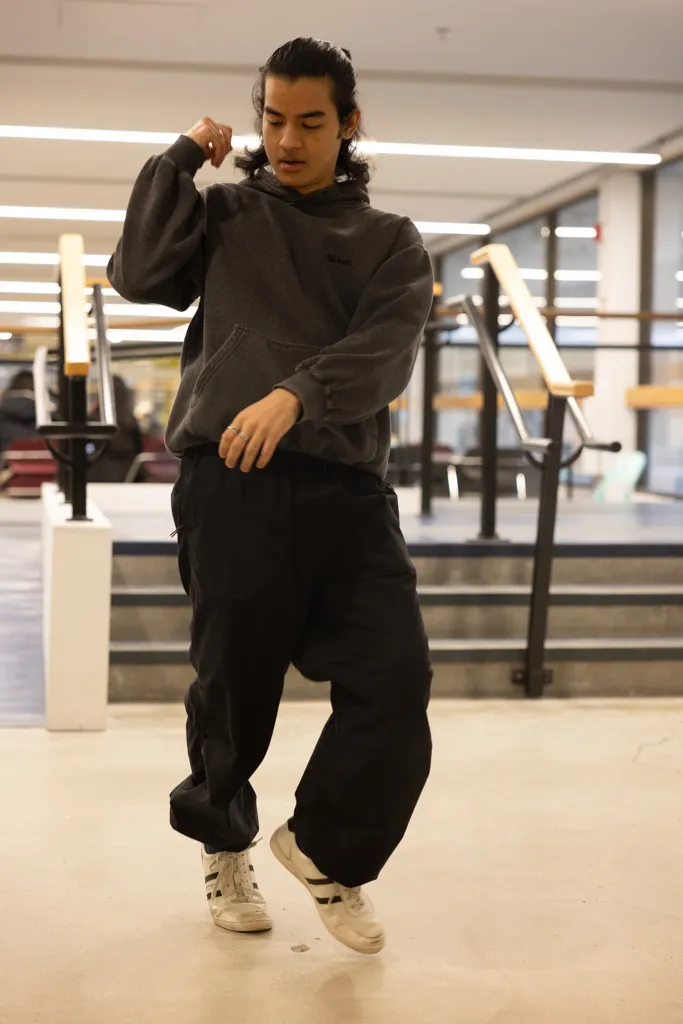Aayush Raghuvamshi grew up watching Bollywood movies and imitating the actors on the screen.
Eventually Tiger Shroff, a famous Bollywood star, reposted one of Raghuvamshi’s videos and it went viral.
Raghuvamshi now performs as a breaker with the Unlimited Dance Club at UBC. But it wasn’t until October 2022 that he began tackling new freestyle terrain instead of the set choreography he was comfortable with.
“In the beginning you feel so lost, because you’re just trusting your body to move in a certain way to a [song] you’ve never heard,” Raghuvamshi said.
Now, when Raghuvamshi competes in dance battles, he occasionally pulls out a push-up move that springs him into an aerial 360° twist. But before he could flip in the air, he had to learn the basics.
“Once you’ve learned to just bounce, then you start to add motion ... you really trust yourself a little more [to] let yourself move with the music.”
Breaking, or b-boying, has roots in martial arts and gymnastics. Originating in early 1970s New York, breaking is credited to DJ Kool Herc, the first to string together bass-heavy sections of songs and encourage dancers to come forward and express themselves to the beat.
Half a century later, breaking and other hip-hop dances like locking continue to push dancers’ emotional, physical and creative expressions.
Unlimited Dance Club, and its competitive team Project U&G, are initiatives that draw on these influences.
Project U&G’s marketing coordinator and locker Normey Liu feels most empowered and expressive in performance when she is conveying her passion to an audience. Like Raghuvamshi, she felt nervous for her first battle, but that did not stop her from leaving her comfort zone.
Liu’s mindset stems from the belief that she must continue to push her limits while dancing, because “time will give [her] feedback” with the more effort she puts in.
“I sometimes feel upset before and during dance practices, because I feel like I cannot express the music as I want,” Liu wrote to The Ubyssey. “But after a good session, I [feel] motivated and ... want to practice more and get better.”
Although locking and breaking are considered more relaxed styles of dance compared to forms like ballet, the improv and freestyle elements are no less demanding nor limiting mediums.
“[Ballet follows] a very strict guideline of what you’re supposed to do,” said Kshitij Gupta, the Unlimited Dance Club’s president. “There’s a right technique and there’s wrong technique.”
“These differences [between hip-hop and other genres are] not just in the physical movements but also in the philosophies, cultural backgrounds, and expressive freedoms these styles embody,” Project U&G’s locking instructor Kelly Duan wrote to The Ubyssey.
“While classical forms often adhere to strict choreography, [hip-hop] styles encourage dancers to develop their own unique style and incorporate freestyle elements into their performances,” she wrote.
Duan uses locking to express herself and believes it is the “happiest style of dance.” It brings out the funky side of performers, and inspires character and playfulness.
Unlike classical dance, the audience does not necessarily sit quietly and watch the dancers perform, but rather cheers and encourages the artists to express themselves fully.
And so do the other performers — dancers feed off of each other and encourage their battling opponents to break through limits, from gymnastic handstands to martial arts windmills.
Hip-hop creates a unique atmosphere where no one is a bystander.
Speaking on the more flexible expression breaking and other hip-hop styles permit in routines, Gupta described a battle he witnessed where “one of the judges [incorporated] movements that would be more traditionally considered house [moves] into her breaking set.” It was something he had not seen in many contemporary sets before.
Although there is freedom in breaking, Gupta pointed to the frustrating limitations he overcame when he stepped away from dance for a couple years in high school. He initially felt disheartened he was no longer at his previous physical level, but that led him on a personal journey to figure out why he sought out dance as a form of expression.
“Do I dance because I want to look cool? Do I dance because it gets me to win competitions? Do I dance because I want to impress someone?” Gupta said. “Or do I dance because that’s what I like to do?”
From his journey, Gupta learned that, ultimately, dance is a tool for self-expression — and “it shouldn’t be anything deeper than that if you don’t want it to be.”
“I’ve never felt like I’ve mastered anything in dance at all,” Raghuvamshi said. “I think that’s kind of beautiful too, because then there [is] always something new for you to explore.”


